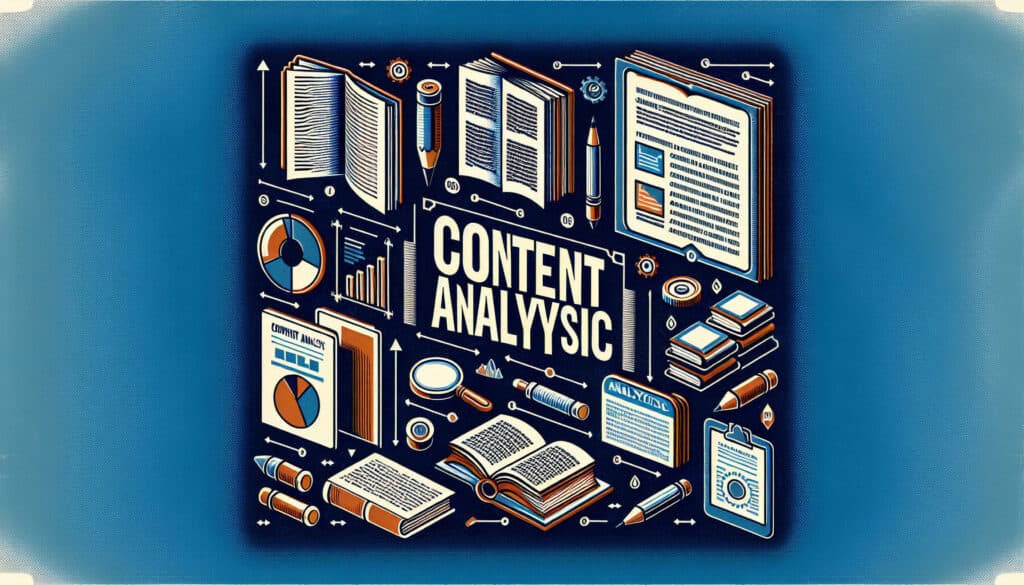Una tecnica di ricerca utilizzata per fare inferenze replicabili e valide interpretando e codificando il materiale testuale.
- Metodologie: Clienti e marketing, Ideazione, Progettazione del prodotto
Analisi dei contenuti

Analisi dei contenuti
- Analisi della varianza (ANOVA), Analisi ambientale comparata, Ricerca e sviluppo, Analisi statistica, Controllo statistico del processo (SPC)
Obiettivo:
Come si usa:
- I ricercatori categorizzano e analizzano sistematicamente testi, immagini o altri media per identificare schemi, temi e significati. Può essere quantitativo (contare le parole) o qualitativo (interpretare i temi).
Professionisti
- Fornisce un metodo sistematico e oggettivo per analizzare i dati qualitativi, è in grado di gestire grandi volumi di dati testuali e può essere utilizzato per scoprire tendenze e modelli nella comunicazione.
Contro
- Può richiedere molto tempo, lo sviluppo di schemi di codifica può essere soggettivo e può trascurare il contesto o le sfumature della comunicazione.
Categorie:
- Clienti e marketing, Risoluzione dei problemi
Ideale per:
- Analizzare sistematicamente contenuti testuali o visivi per identificare e quantificare schemi e temi.
L'analisi dei contenuti trova un'ampia gamma di applicazioni in vari settori, tra cui il marketing, gli studi sui media, le scienze sociali e la ricerca sull'esperienza dell'utente nella progettazione dei prodotti. In settori come lo sviluppo tecnologico o i beni di consumo, questa metodologia può essere fondamentale durante la fase esplorativa dello sviluppo di un prodotto, in cui la raccolta di feedback degli utenti da sondaggi, social media, forum e recensioni dei clienti fornisce preziose indicazioni sulle esigenze e le preferenze degli utenti. Gli analisti o i ricercatori di design iniziano questo processo, spesso supportati da team interfunzionali come gli strateghi del marketing e i data scientist che contribuiscono alla raccolta e all'interpretazione dei dati. Ad esempio, un'azienda che lancia un nuovo dispositivo elettronico può analizzare le recensioni dei clienti e le discussioni online per identificare i temi ricorrenti relativi alla funzionalità, all'esperienza d'uso o ai problemi comuni che gli utenti devono affrontare. Questo approccio può rivelare non solo i sentimenti prevalenti, ma anche aree specifiche di miglioramento che possono guidare le iterazioni di progettazione. L'adattabilità dell'analisi dei contenuti le consente di evolversi, combinando elementi quantitativi, come il conteggio della frequenza di determinate parole chiave o frasi, con interpretazioni qualitative che danno spessore alla comprensione dei sentimenti degli utenti. Inoltre, la sua capacità di elaborare grandi insiemi di dati la rende particolarmente utile per le organizzazioni che intendono seguire i cambiamenti nel comportamento dei consumatori o le tendenze nel tempo, informando così le decisioni strategiche e guidando l'innovazione nell'intero processo. ciclo di vita del prodotto.
Fasi chiave di questa metodologia
- Definire le domande di ricerca o gli obiettivi che guidano l'analisi.
- Selezionare il tipo di contenuto da analizzare, come testo, immagini o media audiovisivi.
- Sviluppare uno schema di codifica basato su categorie predefinite o sulla codifica aperta.
- Codificare il contenuto in modo sistematico, applicando lo schema di codifica a ogni dato.
- Utilizzare gli strumenti software, se applicabili, per la gestione dei dati e l'analisi dei contenuti codificati.
- Analizzare i dati codificati per identificare tendenze, modelli e temi.
- Interpretare i risultati sulla base dei temi e dei modelli identificati nel contesto degli obiettivi della ricerca.
Suggerimenti per i professionisti
- Utilizzare strumenti software per la codifica e l'analisi automatizzata per gestire in modo efficiente grandi insiemi di dati, riducendo al minimo gli errori umani e le distorsioni.
- Incorporare metodi misti, integrando metriche quantitative con interpretazioni qualitative per arricchire i risultati e la convalida.
- Affinare continuamente lo schema di codifica attraverso l'analisi iterativa, consentendo l'emergere di nuovi temi man mano che la comprensione dei dati si evolve.
Leggere e confrontare diverse metodologie, raccomandiamo il
> Ampio archivio di metodologie <
insieme ad altre 400 metodologie.
I vostri commenti su questa metodologia o ulteriori informazioni sono benvenuti su sezione commenti qui sotto ↓ , così come tutte le idee o i link relativi all'ingegneria.
Contesto storico
1828
1850
1854
1854
1911
1928
1950
1827
1848
1850
1854
1895
1914
1943
1970
(se la data non è nota o non è rilevante, ad esempio "meccanica dei fluidi", viene fornita una stima approssimativa della sua notevole comparsa)















Post correlati
Simulazione di Monte Carlo
Test basati su modelli
Controllo del modello
Ricerca con metodi misti
A prova di errore (Poka-Yoke)
Test del profilo di missione